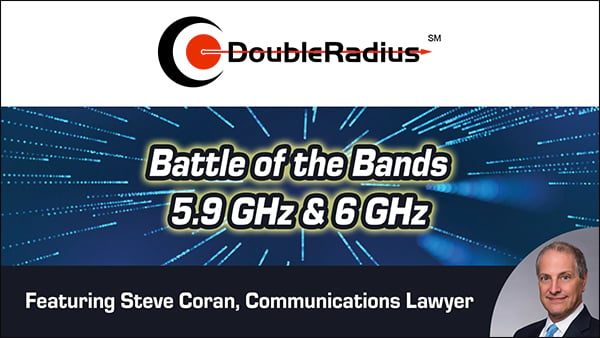My name is Steve Coran, and I'm a Communications Lawyer with Lerman Senter in Washington, D.C. As much of my work relates to the Wireless Internet Service Provider (WISP) industry, DoubleRadius recently invited me to present on what I felt was the most timely, need-to-know information. Since I believe that the recent activity surrounding the 5.9 GHz & 6 GHz frequency bands should have every WISP's attention, I decided to make this the focus of our webinar. In the article below, you'll find a summary of the main points that I shared in from my presentation, which we called, "Battle of the Bands - 5.9 GHz & 6 GHz."
6 GHz Spectrum Now Approved for Unlicensed Use!
Until recently, 6 GHz use was limited to licensed incumbents such as public safety, critical information infrastructure, and a limited number of Wireless Internet Service Providers (WISPs). 6 GHz licensed use among these WISPs has included both microwave backhaul and dedicated internet access (DIA).
In April, 2020, despite resistance from utilities over potential interference, the Federal Communications Commission (FCC) adopted an order allocating 1200 MHz for unlicensed use. All 1200 MHz was approved for low power indoor WiFi 6, and 850 MHz of that spectrum was also approved for "standard power" outdoor operations, split between the U-NII-5 and U-NII-7 bands. However, operation in these bands must be controlled by Automated Frequency Coordination (AFC), which is being developed by a multi-stakeholder group. Until the AFC is developed and approved by the FCC, standard power unlicensed use will not be permitted. The entire 6 GHz band plan is outlined below:
|
|
|||
| Sub-band | Specification Frequency Range (MHz) | Primary Allocation | Specification Predominant Licensed Services |
| U-NII-5 | 5950-6425 |
|
|
| U-NII-6 | 6425-6525 |
|
|
| U-NII-7 | 6525-6875 |
|
|
| U-NII-8 | 6875-7125 |
|
|
AFC and 6 GHz Band Interference Protection
The goal of AFC is to enable unlicensed use while protecting Part 101 licensed microwave links from harmful interference. AFC is similar to a Spectrum Access System (SAS), but is easier to implement because there is no government or mobile use, and there are no multiple tiers of spectrum access. There is also no concern for interference to space station for Fixed Satellite Service (FSS) receivers. Similar to the TV Whitespace (TVWS) database, AFC uses a centralized model. Since it relies on Universal Licensing Service (ULS) for incumbent information, licensees should ensure that their license files are accurate.
6 GHz Unlicensed Devices
Unlicensed devices in the 6 GHz frequency band must incorporate geo-location capability, meaning that they can obtain coordinates from an external GPS source, or from an internal GPS source when that is not feasible. For Point-to-Multi-Point (PTMP) outdoor standard power operation, professional installation is not required. However, information provided must include the height above ground of the access point, and the device must check the AFC daily to obtain the latest list of available frequencies.
New Unlicensed 5.9 GHz Spectrum?
The auto industry accounts for the incumbent licensees in 5.9 GHz frequency spectrum (5850-5925 MHz). Their primary use of this 75 MHz has been Dedicated Short-Range Communications (DSRC) of safety technology for vehicles. In Nov. of 2019, the FCC proposed splitting the spectrum into two pieces:
- 5850-5895 MHz for unlicensed (U-NII-4)
- 5895-5925 MHz for transportation and vehicle safety
As you might imagine, this is a welcome idea for WISPs. The auto industry, however, is advocating to keep all 75 MHz to themselves, especially as they have plans for new Cellular Vehicle-to-Everything (C-V2X) technology.
Special Temporary Authorization (STA) in 5.9 GHz
The plot thickens. In the early stages of the COVID-19 pandemic, the FCC granted over 100 Special Temporary Authorizations (STAs) in the 5850-5895 MHz band, albeit with provisions to protect DSRC and military bases. This has enabled WISPs to handle the increase in broadband to accommodate remote learning, work from home, and telemedicine.
Many original STAs from the April timeframe have already been renewed and extended. With no known cases of harmful interference, this serves as a successful test run for shared co-channel access. This also makes the case for continual use of the band before DSRC licensees migrate to the upper 30 MHz, should that come to pass. Until the FCC makes its ruling (hopefully by the end of 2020), tensions will remain high between the FCC and Dept. of Transportation (DOT), as well as communications and the auto industry.
Interested in Learning More?
Watch the full webinar recording for my complete presentation on 5.9 GHz & 6 GHz, which includes some bonus material on 4.9 GHz and 3.45-3.55 GHz. Also, check out these other WISP articles I've recently written. And if you haven't already subscribed for blog updates, take a minute to do that now. By subscribing, you'll receive a notification each time a new article is published.
Subscribe for Blog Updates
(use form on this page)

